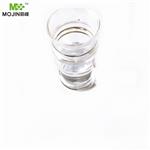Chemical Properties
colourless liquid
Uses
Titanium(IV) ethoxide can be used:
- As an activator and dehydrating agent for by condensation of (S)-(+)-p-toluenesulfinamide with aldehydes and ketones to form sulfinimines.
- As a Ti4+ ion source to form complexes of titanium (IV) acrylate with methacrylic acid.
- As a catalyst to synthesize esters of sterically hindered alcohols via transesterification reactions.
Uses
Titanium ethoxide is used widely as a precursor for the synthesis of Ti
4+ ions titania nanoparticles by various techniques such as :
- in the sol-gel synthesis of free-standing ferroelectric lead zirconate titanate nanoparticles
- spherical titania cores, produced either by hydrolysis of Ti(IV) ethoxide droplets in contact with water vapor or
- by preadsorption of the titanium alkoxides into/onto the clay mineral platelets and their subsequent hydrolysis and calcination.
Uses
Titanium(IV) ethoxide is used in organic synthesis and material science. It is involved in the synthesis of anti-perspirants and antifungal agents. Furthermore, it is used to prepare carbon films in association with silicon dioxide. It is also used as a precursor for the synthesis of Ti4+ ions titanium nanoparticles by various methods.
Application
Titanium(IV) ethoxide can be used:
As an activator and dehydrating agent for by condensation of (S)-(+)-p-toluenesulfinamide with aldehydes and ketones to form sulfinimines.
As a Ti4+ ion source to form complexes of titanium (IV) acrylate with methacrylic acid.
As a catalyst to synthesize esters of sterically hindered alcohols via transesterification reactions.
Flammability and Explosibility
Flammable
reaction suitability
core: titanium
reagent type: catalyst
Materials Uses
Titanium ethoxide is used widely as a precursor for the synthesis of Ti4+ ions titania nanoparticles by various techniques such as :
in the sol-gel synthesis of free-standing ferroelectric lead zirconate titanate nanoparticles
spherical titania cores, produced either by hydrolysis of Ti(IV) ethoxide droplets in contact with water vapor or
by preadsorption of the titanium alkoxides into/onto the clay mineral platelets and their subsequent hydrolysis and calcination.





